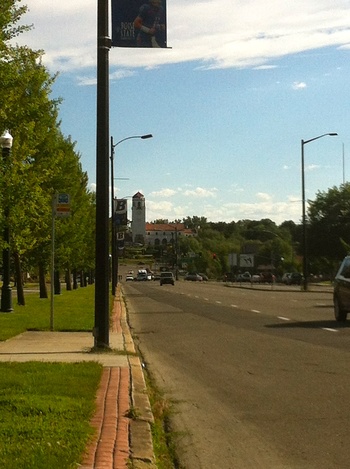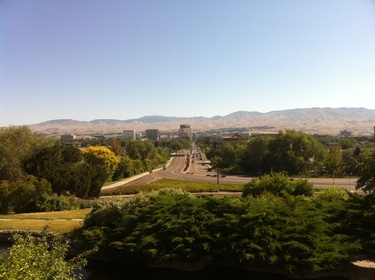The current Boise Depot, a beautiful Mission Revival building, was constructed in 1925 by the Union Pacific Railroad. For Boiseans it was a symbol of great pride. Before the Depot was constructed, Boise was snubbed by the railroad companies due to steep grades and was bypassed for Caldwell. In 1887 the Idaho Central Railway constructed a stub line from Nampa into downtown Boise, rubbing the insult into Boiseans' faces. For 38 years Boise was connected to the rest of the country through the stub line, requiring everything to go to Nampa first. With the construction of the Union Pacific Depot, Boise reasserted its dominance in the valley and was a source of great pride. Two New York architects Carrere and Hastings designed the building in the Mission Revival style, which was popular across the country from about 1890 to the early 1920s. This particular style is exemplified in the Depot because of its stuccoed walls, a tiled roof, curved gables, pierced arches, and a bell tower. The interior design of the building was supervised John Rathrum. There were two sandstone drinking fountains placed at each ends of the waiting room, and the large trusses and rafters were stained brown and decorated with pictures of the evolution of railroading. The Depot was the first building in Boise with the Mission Revival style, and it inspired many Boiseans to construct bulidings that harkened to the same style. Some examples of this can be found in a large mansion on Harrison Boulevard; a spattering of houses all over town; the Bandshell in Julia Davis Park; the former Macy's building in downtown Boise; and the Peasley House (which is just down from the Depot on Crescent Rim Drive). Unfortunately, passenger trains no longer travel to Boise. There have been efforts to bring back a commuter train that would run between Caldwell and Boise. This would reduce the air pollution in the valley and decongest the freeways, while also opening up the valley again to passenger trains that tourists ride on. They would still be able to get off the train at the beautiful Boise Depot, and be a short walk or taxi ride into downtown Boise. The picturesque approach from the Depot to the Capitol building is permanently obstructed with the Key Bank building and the other structures lining Capitol Boulevard. Views of the east and west wings of the Capitol Building are obstructed and only the south facing entrance and the dome are viewable from the Depot.
 South facing view of the Depot off Capital Blvd*
South facing view of the Depot off Capital Blvd* Depot @ sunset prior to 4th of July fireworks. SW facing off Capital/Vista Blvd*
Depot @ sunset prior to 4th of July fireworks. SW facing off Capital/Vista Blvd*
 Front view of the Boise Depot*
Front view of the Boise Depot* Sandstone Union Pacific emblem*
Sandstone Union Pacific emblem* North view from the Depot*
North view from the Depot*
 Hopefully trains will once again use the Depot.*
Hopefully trains will once again use the Depot.* Close view of an engine car.*
Close view of an engine car.* Today locomotives rarely travel though the Depot.*
Today locomotives rarely travel though the Depot.*
*Photo by P. Browning image copy/reproduction for educational purposes only.
Comments
Historic Boise Depot
In 1887 the city constructed a simple board and batten gable roof depot on the Boise Bench, and citizens celebrated the arrival: “The long hoped for railroad has reached Boise City. The novelty of seeing a train of cars on the opposite side of Boise River was enjoyed by the people on Saturday last [. . .] On Sunday the road from town to the depot was lined with people nearly all day. This distance is about a mile, and the more fortunate ones rode in carriages, others in lumber wagons, and others on horseback, while hundreds of men, women and children walked over. It is safe to say that 1000 visited the railroad Sunday.” Idaho Daily Statesman, July 9 and 28, 1887
The first depot in Boise was located south of downtown Boise (very near the modern depot's current location) at the end of a mile long dirt road and across two different bridges, one crossing the Boise River and then another at the steep climb up the bench, terminating at the depot, the journey was loathed by many of the citizens of Boise who dreaded the dusty or sometimes muddy one-mile journey to and from “the stub,” a name callously applied by locals.
Map, Sanborn Fire Insurance Company, 1893 Available at http://www.boisestate.edu/history/cityhistorian/atlas_reinvent/atlas_reinvent.html# a project by Johnny Hester, Boise State University, MAHR
Boise really celebrated when an impressive new stone depot was erected at 10th and Front Streets near the town’s center. The structure and corresponding tracks, completed in 1893, brought immediate change to the city of Boise as the tracks brought the trains alongside Front Street through town.
Oregon Shortline Train at Old Passenger Depot, Boise, Idaho Front and 10th Streets ca. 1900. Courtesy Idaho Historical Society 69-4.40/B




